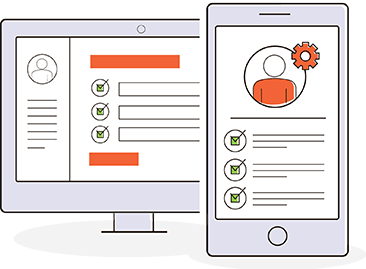What is Offboarding?
The importance of offboarding, to employees and organizations alike, cannot be understated.

Offboarding, or employee exit management, is an essential and effective way to wrap up with a departing employee. It’s a critical way to collect insights, knowledge, and perspective from the departing employee and ensure a smooth transition.
What is offboarding?
Offboarding is a process that can occur when an employee resigns or retires, but it can also be used when employees are laid off or even fired. It protects the employee and the organization and helps to, whenever possible, ensure that the employee leaves on good terms.
Employee offboarding is about tying up loose ends and providing closure for the employee. It can also be a way employers can protect themselves legally from any issues related to the departure or the employee’s tenure.
Overview of what offboarding entails
While the specific structure of offboarding varies among organizations, the process has several standard elements. Offboarding is a meeting or series of meetings, along with actions, designed to achieve five key objectives:
- Transferring knowledge
- An exit interview
- Completion of administrative tasks
- Managing transition paperwork and documentation
- Communication of the departure
While offboarding is essential for the organization and the employee, it also considerably impacts the corporate culture. Employees know that their insights and perspectives will be heard when they leave by providing a clearly defined offboarding process.
Understanding Offboarding
Offboarding has a significant place in organizations of all kinds. Its importance to employees and organizations alike cannot be understated.
Definition and significance of offboarding
At its most fundamental, the process allows for a smooth transition for the departing employee and can improve the onboarding of a new employee. A positive offboarding experience also can establish the potential for the employee to return to the organization.
Departing employees have a wealth of information that can help shape operations and HR approaches. Their insights on their jobs can help their successors and former colleagues manage their work more effectively.
Often, employees may tweak procedures or processes that enhance efficiency. The offboarding process is an excellent way to understand these nuances.
For organizations, the offboarding process can provide invaluable insights. Often, departing employees will be more candid about what works and doesn’t work within the organization. Understanding why an employee leaves allows one to learn and understand what can be changed to improve the employee experience.
Critical differences between offboarding and onboarding
There are many differences between offboarding, which occurs at the end of the employee cycle, and employee onboarding, which occurs as a worker starts their role.
Both are essential processes that provide a framework and context for the employee. They are also important moments when the organization can demonstrate the corporate values to which it ascribes.
Both processes usually require extensive reviews of policies and the completion of paperwork. At the onboarding stage, employees complete benefits enrollment forms, work eligibility paperwork, review and agree to abide by policies, and receive equipment.
During offboarding, paperwork may entail address forwarding, calculation of owed salary, wages, or other earnings, and information on the continuation or cessation of benefits. Information on noncompete agreements, unemployment benefits, and other specific items may also be reviewed. Employee-issued equipment may be retrieved.
The role of HR and management in the offboarding process
Both human resources staff and management are typically involved in different aspects of the offboarding process. Managers, for example, may handle the process's knowledge transfer and communication aspects. HR staff are more likely to manage the paperwork and conduct the exit interview.
 The Components of Offboarding
The Components of Offboarding
As noted, the components of employee offboarding can vary from organization to organization. However, here are the most common.
Exit interviews
The exit interview is an opportunity to gather insights from the departing employee about all aspects of the work. These insights can run the gamut from leadership and feedback provided by the supervisor to company culture and workplace concerns.
The interview can provide information about what the organization does well, what needs to be improved, and what the employee’s experience has been working for the organization.
Feedback from the interview can provide information about workload, working conditions, leadership, compensation, and work-life balance. Asking the right questions helps to glean information that can be quantified, analyzed, and used to improve the experiences of other employees.
Here are some sample exit interview questions to consider:
- What did you like best about your job?
- What did you dislike about your job?
- What was your relationship like with your supervisor? Your coworkers?
- Did the job meet your expectations? Why or why not?
- What about the company culture can we improve?
Remember that the exit interview will be one of the employee's last experiences with your organization. It’s essential to close the loop on the employee’s experience.
Knowledge transfer
Transferring insights, expertise, experiences, and skills is a critical offboarding component. Knowledge transfer prevents the loss of practical information that could disappear once the employee leaves. This step is particularly crucial if a replacement is not hired before the employee’s departure.
A knowledge transfer can begin with the employee detailing their tasks and responsibilities. A supervisor can then review the document with the employee to gather clarity or more details, if necessary.
Here are some key considerations to factor into the knowledge transfer process:
- The daily work routine and how they prioritize and manage the work
- Files and software used, organization of documents, and location of that information
- Key collaborators, both internal and external
- Systems that need training by a replacement or someone else
- Transfer of ownership of Google Drive or other file systems
- A running list of current, annual, or seasonal projects and tasks and whether they will be completed before the departure
By using documentation and technology, you can ensure a seamless transition from one employee to the next.
Administrative tasks
Collecting any company property distributed, including laptops, smartphones, tablets, passes, memberships, and keys, is essential.
Here, any legal obligations, such as ownership interests, stock options, or other contractual obligations, are addressed. Ensuring no questions about obligations can eliminate problems down the road.
Managing paperwork and documentation
Paperwork and documentation are extensive in offboarding. Information about benefits, nondisclosure agreements, return of company property, and other details needs to be shared and, in some cases, signed by employees and/or company officials.
Communication
Communication is essential when an employee leaves. The tenor, content, and voice of the communications are crucial. Different types of communication may be necessary for different constituents, all timed carefully.
Communication audiences include closest colleagues or the department, organization-wide communications, and notices sent to stakeholders, customers, and partners.
Developing sensitive, professional departure announcements that provide appropriate detail is important. Sometimes, sharing drafts of departure notices with the employee may be prudent.
 Offboarding Best Practices
Offboarding Best Practices
Finding the right approach to your offboarding requires an organizational commitment to getting it right. Here are a few considerations.
Automate Forms, Tasks, and Workflow
By using a workflow automation platform to create online forms, assign tasks, and automate offboarding workflow, you can ensure that all the critical steps of the process happen as expected in a consistent, standardized way. Use alerts, reminders, and escalations to enforce turnaround time requirements. Digitally store all forms and information to ensure retention of records and integrate them with your HRIS system. Provide a complete activity audit trail when required by legal or regulatory requirements.
Tailoring offboarding to different scenarios
The steps taken in offboarding will vary significantly based on the types of departures and the circumstances surrounding the exit. Not all steps are appropriate for certain departures. For example, exit interviews with fired employees may not be appreciated or accepted.
Many experts recommend following the same process, no matter the separation type. However, consider developing specific offboarding strategies for voluntary vs. involuntary departures. In an involuntary departure, for example, team members may be surprised and emotional, worried about the impact on them and their work.
Additional steps may be necessary for retirement and phased exits, especially when retirement celebrations are planned.
Offboarding remote or contract employees has its nuanced components. Equipment, for example, may need to be returned via a shipping service with prepaid shipping labels.
Developing an Offboarding Strategy
The critical thing to remember is to create a standardized offboarding process shared with employees and managers. Manager training should include what an offboarding process comprises and the manager’s role.
While a standardized process is wise, it’s also important to maintain flexibility and adaptability in offboarding approaches. Consistency is essential, but so too is adapting to different scenarios that may require a more nuanced approach.
One of the elements that organizations often forget is to use the information gained in the offboarding process. Offboarding provides incredibly detailed data that can be analyzed and used to foster continuous improvement in the employee lifecycle.
Legal and Compliance Considerations
Employees must know that exit interviews are not legally required and that you will not force an employee to complete one. The only exception is if participation is part of an employment contract.
Many employees are reticent to participate for fear of reprisals. You can assure employees that information provided during an interview will not be shared with others unless legally mandated to do so.
Legal elements come into play in several components of offboarding. It’s crucial to protect sensitive company information, including intellectual property, and ensure that it is not taken by the employee. This scenario is especially true of the employee is departing for a competitor.
If there are non-compete clauses or confidentiality agreements in play, the offboarding process is an excellent time to review the conditions of said agreements.
The Organizational Benefits of Effective Offboarding
There are many benefits to having a sound offboarding strategy, including:
- Preserving Institutional Knowledge. Offboarding allows the organization to retain the crucial skills, insights, and work expertise of the departing employee.
- Enhancing Employer Branding. A commitment to offboarding shows current and potential employees that the organization is committed to them and their welfare throughout their employment tenure. The process shows a commitment to best HR practices.
- Reducing Loss and Damage. Employers can reduce the risk of assets and intellectual property being damaged, lost, or stolen by having a well-thought-out offboarding process. For example, many organizations restrict or remove access to sensitive company systems when the employee is notified of a departure or gives notice.
- Mitigating Legal and Reputational Risks. The offboarding steps ensure that all key legal points are covered and that the risks of legal exposure and loss of reputation are reduced.
The Future of Offboarding
Technology is revolutionizing HR, including offboarding. Online forms, digital signatures, and automated work processes can track progress on various steps. AI tools can provide answers to common questions and accelerate completion while still offering a personal approach.
As remote and hybrid work becomes the norm, it’s a good time for organizations to reconsider their offboarding. Remote workers may have different relationships, little to no physical contact with the onsite workspace, and work experiences. That may make them feel less connected, but it also may cause them to be more candid in exit interviews.
As employee expectations and needs evolve, it will be incumbent on organizations to consider carefully how to evolve offboarding to relate to and be effective for employers and employees alike.
Conclusion
Offboarding is an essential component of the employee lifecycle. It provides closure, insights, and details that can help improve the organization extensively.
Organizations can boost employee engagement and employer brand reputations by taking a compassionate, proactive approach to employee departures. Offboarding can be a satisfying conclusion to an employee’s tenure when done right.


